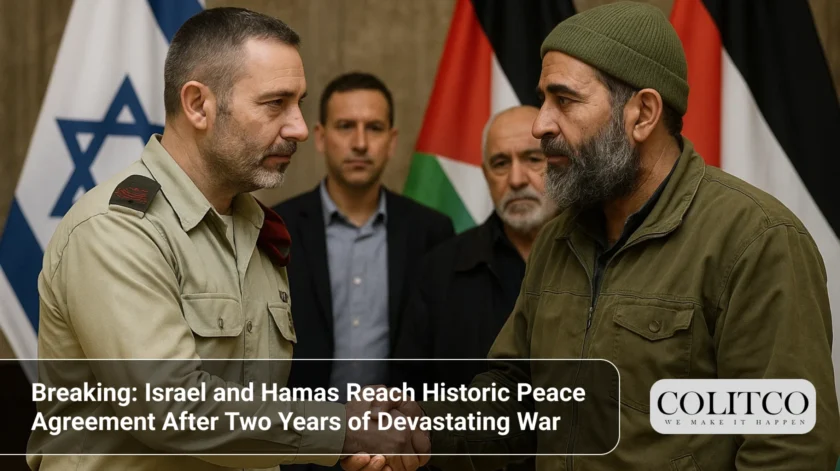The world witnessed a major diplomatic breakthrough on Wednesday as President Donald Trump announced that Israel and Hamas have signed off on the first phase of a comprehensive peace agreement. The deal represents the most significant step towards ending the Gaza conflict since October 2023.
Speaking from the White House, Trump declared it a “great day for Israel and for the world,” confirming that both parties had agreed to the initial framework after intensive negotiations in Egypt.
The First Phase: What’s Been Agreed
The agreement centres on immediate, concrete steps to de-escalate the two-year conflict.
I am very proud to announce that Israel and Hamas have both signed off on the first Phase of our Peace Plan. This means that ALL of the Hostages will be released very soon, and Israel will withdraw their Troops to an agreed upon line as the first steps toward a Strong, Durable,…
— Trump Truth Social Posts On X (@TrumpTruthOnX) October 8, 2025
Under the first phase terms, Hamas will release nearly 50 Israeli hostages—both living and deceased. Israel has committed to releasing approximately 250 Palestinian prisoners serving life sentences, plus 1,700 Palestinians detained since the war began.
Israeli forces will withdraw to an agreed-upon line within Gaza. This partial withdrawal marks the first significant pullback since the conflict’s inception.
Trump emphasised that “ALL of the Hostages will be released very soon,” with Israeli Prime Minister Benjamin Netanyahu confirming Thursday’s cabinet meeting to ratify the agreement.
The Path to Agreement: High-Stakes Negotiations
The breakthrough followed three days of indirect talks in the Egyptian resort town of Sharm el-Sheikh. Hamas negotiator Khalil al-Hayya led Palestinian discussions, while Israeli Strategic Affairs Minister Ron Dermer headed the Israeli delegation.
U.S. Special Envoy Steve Witkoff and Jared Kushner joined negotiations as mediators. Qatar and Egypt also played crucial roles in facilitating dialogue between the parties.
The Trump administration’s diplomatic pressure proved decisive. On Friday, Trump issued Hamas an ultimatum with a Sunday deadline, warning that rejecting the proposal would unleash “all hell” on the militant group.
Hamas responded positively, agreeing to:
- Release all Israeli hostages
- Hand Gaza administration to independent Palestinian technocrats
- Accept international supervision during the transition
The Bigger Picture: Trump’s 20-Point Plan
Wednesday’s agreement covers only the initial phase of Trump’s ambitious 20-point framework unveiled in late September.
The comprehensive plan addresses thornier long-term issues still requiring negotiation:
- Phase Two: Release of remaining hostages, increased prisoner exchanges, and Israel’s commitment to end military operations.
- Phase Three: Complete Israeli withdrawal, Hamas disarmament, Gaza reconstruction, and potential pathways to Palestinian self-determination.
Trump described the plan as ending a “3,000 YEAR CATASTROPHE,” though critics note the challenging negotiations ahead on Hamas demilitarisation and Gaza’s future governance.
The Human Cost
Gaza’s Health Ministry reports over 67,000 Palestinians killed since October 7, 2023. Israel suffered approximately 1,200 deaths in Hamas’s initial attack, mostly civilians attending a music festival.
The conflict has reduced much of Gaza to rubble. Humanitarian organisations estimate over 2 million Palestinians face desperate shortages of food, medicine, and shelter.
Israeli hostage families have endured 15 months of anguish. Many criticised Netanyahu’s government for prioritising military objectives over hostage recovery.
ALL hostages to be released very soon! https://t.co/tmNrNaQwxi pic.twitter.com/XGjfj9Wm65
— The White House (@WhiteHouse) October 8, 2025
Regional and International Response
The announcement drew widespread international support. Foreign ministers from Qatar, Jordan, Turkey, Saudi Arabia, Egypt, and the United Arab Emirates welcomed Trump’s mediation efforts.
United Nations Secretary-General António Guterres urged all parties to “seize the opportunity to bring the tragic conflict in Gaza to an end.”
Palestinian Authority President Mahmoud Abbas praised the ceasefire but emphasised concerns about reconstruction and preventing displacement.
European Union officials indicated interest in participating in Gaza’s transitional governance structures.
Challenges Ahead
Despite Wednesday’s optimism, significant obstacles remain.
Israeli airstrikes continued through the weekend despite Trump’s demand that Israel “immediately stop the bombing.” Gaza’s Civil Defense warned residents to exercise extreme caution, noting defensive fire protocols remain active.
Hamas’s statement notably avoided committing to full disarmament—a cornerstone of Trump’s broader plan. The group insists on “real guarantees” that Israel won’t restart military operations.
Who will govern Gaza post-conflict remains contentious. Netanyahu’s government insists Hamas must be completely excluded from any administrative role.
What Happens Next
Netanyahu’s cabinet meets Thursday to ratify the agreement. Israeli officials expect the first hostages could return as early as Monday.
A verification mechanism based in Cairo will monitor compliance. Representatives from Israel, Hamas, the US, Egypt, and Qatar will oversee implementation.
The mechanism already proved functional in late January when it resolved a brief crisis over hostage release sequencing within 24 hours.
Trump indicated he would likely visit Israel in coming days to mark the historic agreement.
Also Read: Court Battle Erupts as Police Sound Alarm Over Major Gaza Rally Near Sydney Opera House
FAQs
Q: When does the ceasefire take effect?
A: Following Thursday’s Israeli cabinet ratification, the ceasefire becomes operational immediately, with hostage releases beginning within days.
Q: How many hostages are being held?
A: Approximately 48 Israeli hostages remain in Gaza, with about 20 believed alive.
Q: What happens if Hamas doesn’t disarm?
A: Phases two and three remain contingent on Hamas meeting disarmament commitments. This remains the agreement’s most contentious element.
Q: Who will govern Gaza?
A: The agreement calls for independent Palestinian technocrats under international supervision, though specific structures require further negotiation.












